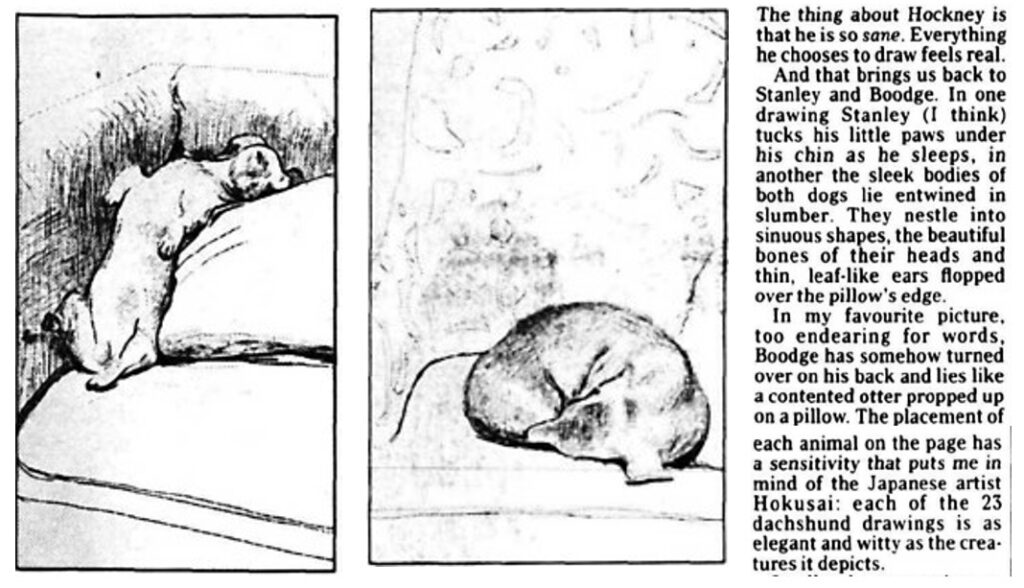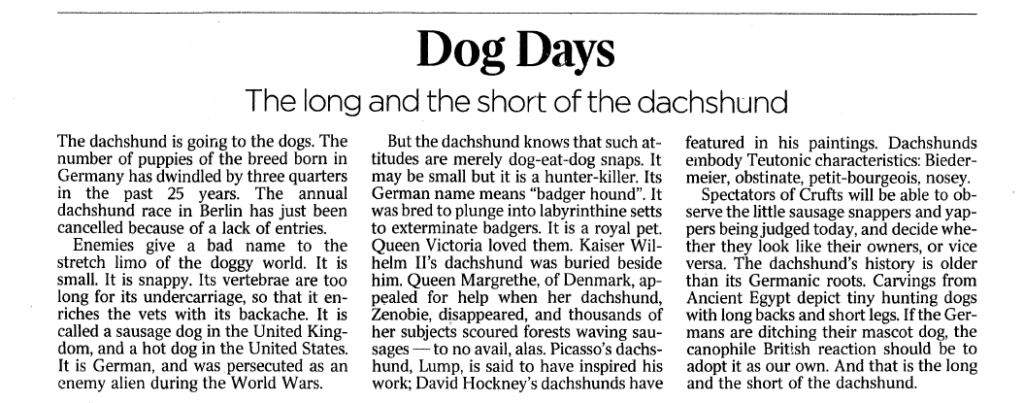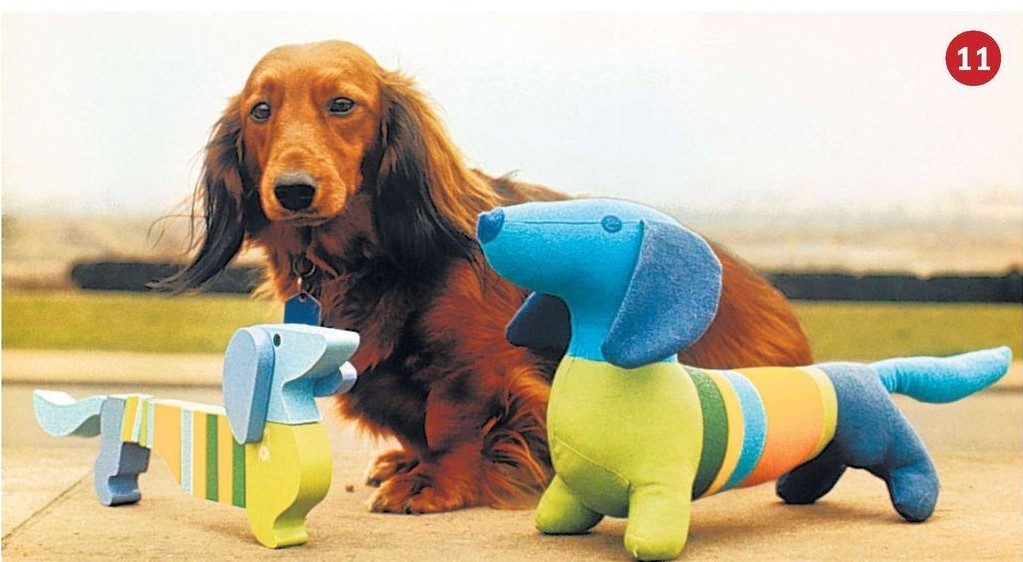│By Jasmine Weller, Inside Sales Executive for Eastern Europe │
Weenie. Wiener. Dashie. Datsun. Doxin. Doxie. Sausage dog. Hot dog. Teckel. Dackel. No matter what you like to call them, there is no denying that the Dachshund is ever growing in popularity thanks to advertising campaigns, dedicated Instagram accounts, a multitude of home interior accessories and ‘those’ sausage dog walks. Being the proud ‘fur’ mum to two of my own, I thought it was time to pay homage to these tenacious little creatures, with the help of Gale Primary Sources.
Crooked-legged and straight-legged Dachshunds
To introduce this Badger Dog, as some would call it, I thought I would start with an article from an 1874 issue of The American Sportsman found in American Historical Periodicals. The author explains the difference between what would now be referred to as ‘miniature’ and ‘standard’ variations of the breed, describing the former as crooked-legged and the latter as straight-legged. Miniature Dachshunds are currently the most popular variation of the breed and the dog with which most people will be familiar. Despite the change in terminology surrounding their size, their stubborn disposition has survived the test of time, with 145 years making little difference to how sulky they can be!

We can see from the illustration that Dachshunds haven’t always been the proud owners of such modest limbs – three-year-old Watchel in the article above measured thirty-seven and a half inches from nose to end of tail, and was nine inches tall. The average Miniature Dachshund today can be as small as five to six inches in height.
A favourite breed of German royalty
Being of German origin, it is no surprise that the Dachshund was a favourite breed of German royalty. In the International Herald Tribune Historical Archive, I found a prime example of the bold and courageous nature of this little dog in the form of Hexe, one of Wilhelm II’s many Dachshunds.

International Herald Tribune Historical Archive 1887-2013,
https://link.gale.com/apps/doc/FFZUVK186591072/GDCS?u=webdemo&sid=GDCS&xid=c866cc2e
Lump, Picasso’s canine companion
The last Emperor of Germany was in good company when it came to his love of these little wiener dogs. Pablo Picasso had a weakness for one particular dog that went by the name of Lump (the German word for rascal), pronounced ‘Loomp’. In a 2006 article from The Independent, I learned about Picasso’s doting relationship with his canine companion, and how little Lump had the life any dog would dream of, sleeping in his master’s bed, eating from the table on a dinner plate that was decorated with his own image and, as the article details, “using a 7ft bronze Picasso statue in the garden as his urinal.”
![Lichfield, John. "One man and his dog." Independent, 1 May 2006, p. [1]+. The Independent Digital Archive](https://www.gale.com/intl/blog/wp-content/uploads/2019/08/image-3.jpg)
It seems that Lump was not only the painter’s friend, but his muse, with Picasso’s versions of the Velázquez painting, Las Meninas, containing Lump in the foreground as a replacement for the Mastiff that can be seen in the originals. Picasso later donated the forty-five-piece series to the Picasso Museum in Barcelona, and David Douglas Duncan, the photographer interviewed in the article above, says it is, “the darndest, and most moving part of the whole story. That little puppy from Stuttgart is preserved there forever on this great series of paintings by one of the greatest masters of modern art.”

Dorment, Richard. “Matching up to the Masters.” Daily Telegraph, 6 June 2006, p. 25. The Telegraph Historical Archive, https://link.gale.com/apps/doc/LHOQWM138930604/GDCS?u=webdemo&sid=GDCS&xid=588f0010
David Hockney’s sketches of Stanley and Boodge
Andy Warhol, David Hockney and John Wayne also keep Picasso and the Kaiser company in their choice of four-legged friends. Like Picasso, Hockney took inspiration from his two hounds – Stanley and Boodge. In a 1994 article now in The Telegraph Historical Archive, the pair are described to have been depicted as the elegant and witty creatures that they are, in a series of 25 dedicated drawings by the artist.

But not everyone found Hockney’s pair to be quite so endearing. In a Sunday edition of the same newspaper, a Telegraph journalist voiced his disdain, for Stanley in particular, describing him as ‘’not nearly the friendly little thing he appears in his master’s portraits”. The writer recounts an incident where a fellow journalist had visited Hockney in California and, as the journalist recalls, “There was this fat little thing…I bent down to stroke it and it bit me.” Apparently, according to Hockney, his canine companion didn’t care much for journalists and could spot them coming. Maybe he was a witty little creature after all…

Waldi, mascot of the Munich Olympics
Before I end this whistle-stop tour of ‘famous’ Dachshunds, Waldi must also get a mention. The first-ever mascot of the Olympics when they were held in Munich in 1972 and styled on German graphic designer Otto Aicher’s very own pup by the same name, the toy represented the “gaiety” and “spirit” of the games. Aicher reportedly chose Waldi the Dachshund because the breed possesses resistance, tenacity and agility – all qualities required by competitive athletes. Although, as you can see from this small snippet found buried in the pages of The Daily Telegraph, the mascot didn’t arrive to much fanfare.

However, later reports detailed his great success, with a 2010 article from The Independent Digital Archive describing Waldi as a commercial and public relations success with over two million Waldi related items being sold worldwide.

The popularity of the Miniature Dachshund
It is clear that the love affair with this little pooch has stood the test of time, but in 2007 an article found in The Times Digital Archive called the Dachshund’s popularity into question, reporting that birth rates in Germany had dwindled by three quarters in twenty-five years. They called for the British reaction to be to adopt the breed as their own.

Almost ten years later in 2016, it seemed that the British public had heeded that advice. The Sunday Telegraph credited Instagram and internet sensations like Bruno and Noodle for bringing back the breed’s popularity – with London seeing a twenty percent rise in Dachshund registrations in the first half of 2015. And, if current trends continue, it seems these furry little nuggets are firmly here to stay.



